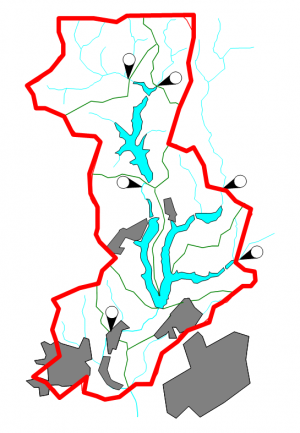Systemabgrenzung/en: Unterschied zwischen den Versionen
(Übernehme Bearbeitung einer neuen Version der Quellseite) |
Ferrao (Diskussion | Beiträge) (Die Seite wurde neu angelegt: „thumb|Example for the delimitation of a study areaThe delimitation of the water management system has to be…“) |
||
| Zeile 3: | Zeile 3: | ||
{{Navigation|vorher=|hoch=Arbeitsschritte zur Modellerstellung|nachher=Unterteilung in Systemelemente}} | {{Navigation|vorher=|hoch=Arbeitsschritte zur Modellerstellung|nachher=Unterteilung in Systemelemente}} | ||
[[Datei:Eingrenzung_des_Untersuchungsgebietes.png|thumb| | [[Datei:Eingrenzung_des_Untersuchungsgebietes.png|thumb|Example for the delimitation of a study area]]The delimitation of the water management system has to be carried out in such a way that all loads and processes important for the problem can be represented in the model, including all system states relevant for control. Often the first delimitation is based on the boundaries of a hydrological catchment area (e.g. determined in a GIS) and is then possibly extended if processes/states outside the area influence the system or if information outside the catchment area is to be used, e.g. for calibration. The system delimitation can also change due to the system elements that are determined after the subdivision into system elements. If subcatchment areas are mapped e.g. as external inflows by [[Special:MyLanguage/Einleitung|point source]], the system boundaries become smaller accordingly. | ||
Nachdem die Systemabgrenzung erfolgt ist, kann das wasserwirtschafltiche System in [[Special:MyLanguage/Unterteilung in Systemelemente| Systemelemente unterteilt]] werden. | Nachdem die Systemabgrenzung erfolgt ist, kann das wasserwirtschafltiche System in [[Special:MyLanguage/Unterteilung in Systemelemente| Systemelemente unterteilt]] werden. | ||
Version vom 25. November 2020, 13:13 Uhr
The delimitation of the water management system has to be carried out in such a way that all loads and processes important for the problem can be represented in the model, including all system states relevant for control. Often the first delimitation is based on the boundaries of a hydrological catchment area (e.g. determined in a GIS) and is then possibly extended if processes/states outside the area influence the system or if information outside the catchment area is to be used, e.g. for calibration. The system delimitation can also change due to the system elements that are determined after the subdivision into system elements. If subcatchment areas are mapped e.g. as external inflows by point source, the system boundaries become smaller accordingly.
Nachdem die Systemabgrenzung erfolgt ist, kann das wasserwirtschafltiche System in Systemelemente unterteilt werden.
